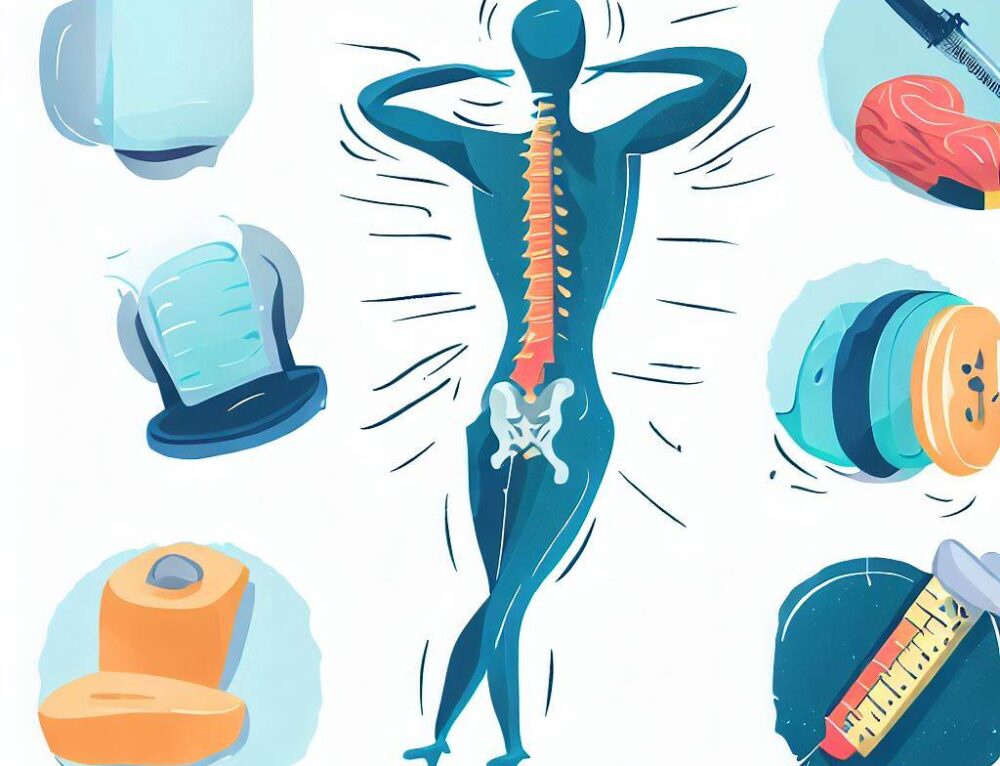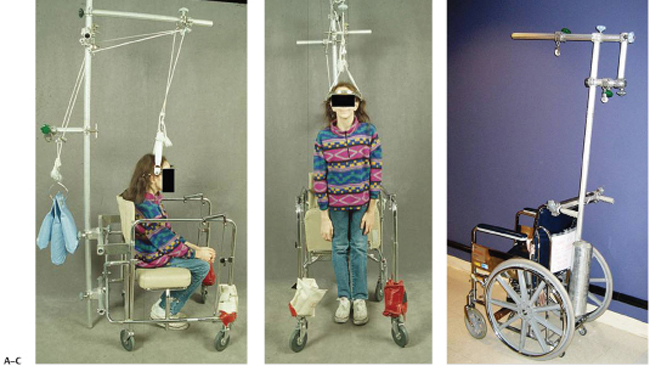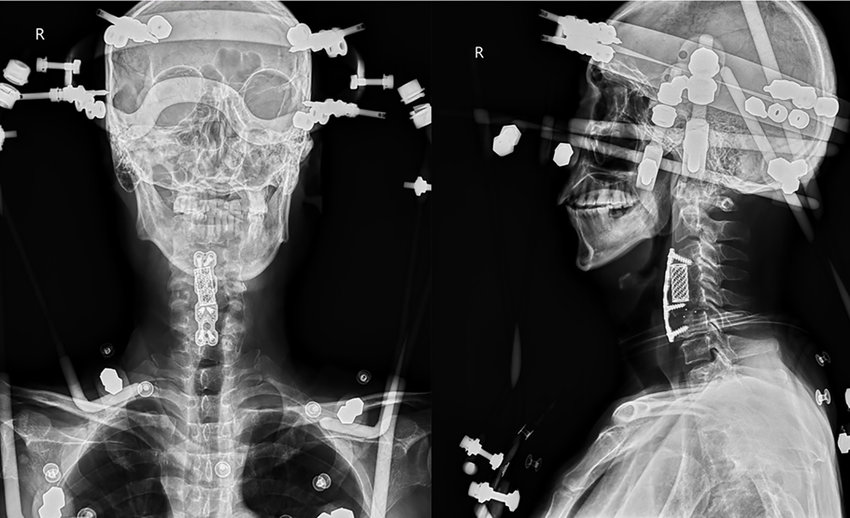Halo Scoliosis: Scoliosis is a medical condition characterized by an abnormal curvature of the spine. It affects approximately 2-3% of the population, with the majority of cases occurring in adolescents. While there are various treatment options available for scoliosis, one method that has gained significant attention is halo traction. Halo traction involves the use of a halo device, which is a metal ring attached to the patient’s skull, to gradually correct the curvature of the spine. In this article, we will explore the use of halo traction for scoliosis treatment, its outcomes, and its potential as a future treatment option.

Skoliose verstehen: Ursachen, Symptome und Diagnose
Before delving into halo traction, it is important to understand the causes, symptoms, and diagnosis of scoliosis. Scoliosis can be caused by a variety of factors, including congenital abnormalities, neuromuscular conditions, and idiopathic causes. Idiopathic scoliosis, which accounts for approximately 80% of cases, has no known cause. Symptoms of scoliosis may include an uneven waistline, one shoulder higher than the other, and an abnormal curvature of the spine. Diagnosis is typically made through a physical examination, followed by imaging tests such as X-rays or MRI scans.

Halo Scoliosis: What is Halo Traction and How Does it Work?
Halo Scoliosis: Halo traction is a non-surgical treatment option for scoliosis that involves the use of a halo device. The halo device consists of a metal ring that is attached to the patient’s skull using pins or screws. The ring is then connected to a traction system, which applies a controlled force to gradually straighten the spine. The goal of halo traction is to correct the curvature of the spine and prevent further progression of scoliosis.

The Role of Halo Traction in Scoliosis Treatment
Halo traction plays a crucial role in scoliosis treatment, particularly in cases where surgery is not immediately necessary or feasible. It can be used as a pre-operative treatment to gradually reduce the curvature of the spine, making the surgical procedure less invasive and more successful. Additionally, halo traction can be used as a standalone treatment option for patients who are not suitable candidates for surgery or who prefer a non-surgical approach. It provides a conservative treatment option that can improve the quality of life for individuals with scoliosis.
Halo Traction: Preparing for the Procedure
Halo Scoliosis: Before undergoing halo traction, patients must undergo a thorough evaluation to determine their suitability for the procedure. This evaluation may include physical examinations, imaging tests, and consultations with a multidisciplinary team of healthcare professionals. Once deemed suitable, patients will undergo a pre-procedure preparation phase, which may involve obtaining informed consent, discussing the procedure and its potential risks and benefits, and ensuring that the patient is mentally and physically prepared for the treatment.
The Halo Traction Procedure: Step-by-Step
The halo traction procedure typically involves several steps. First, the patient is placed under general anesthesia to ensure comfort and minimize pain during the procedure. Next, the halo device is carefully attached to the patient’s skull using pins or screws. Once the halo device is securely in place, the patient is connected to the traction system, which applies a controlled force to gradually straighten the spine. The amount of force applied and the duration of the traction period will vary depending on the severity of the scoliosis and the individual patient’s needs. Throughout the procedure, the patient’s vital signs and comfort level are closely monitored by the healthcare team.
Halo Scoliosis: Potential Risks and Complications of Halo Traction
Like any medical procedure, halo traction carries certain risks and potential complications. These may include infection at the pin or screw insertion sites, discomfort or pain during the traction period, pressure sores, and damage to the skin or underlying tissues. Additionally, there is a small risk of neurological complications, such as nerve damage or spinal cord injury, although these risks are rare. It is important for patients to discuss these potential risks with their healthcare team and weigh them against the potential benefits of halo traction.
Halo Traction: Post-Procedure Care and Recovery
After the halo traction procedure, patients will require a period of post-procedure care and recovery. This may involve pain management, wound care, and physical therapy to help regain strength and mobility. The duration of the recovery period will vary depending on the individual patient and the severity of their scoliosis. Regular follow-up appointments with the healthcare team will be necessary to monitor progress and make any necessary adjustments to the treatment plan.

Halo Traction vs. Other Scoliosis Treatment Options
Halo traction is just one of several treatment options available for scoliosis. Other treatment options include observation, bracing, and surgery. The choice of treatment will depend on various factors, including the severity of the scoliosis, the age of the patient, and their individual preferences. While halo traction can be an effective treatment option for certain patients, it may not be suitable for everyone. It is important for patients to discuss their options with their healthcare team and make an informed decision based on their specific needs and circumstances.
Long-Term Outcomes of Halo Traction for Scoliosis
The long-term outcomes of halo traction for scoliosis vary depending on several factors, including the severity of the scoliosis, the age of the patient, and the duration of the traction period. In some cases, halo traction can lead to a significant reduction in the curvature of the spine, improving the patient’s overall posture and quality of life. However, it is important to note that halo traction is not a permanent solution for scoliosis. It is often used as a pre-operative treatment to prepare the patient for surgery or as a temporary measure to manage the condition. Long-term outcomes will also depend on the patient’s adherence to post-procedure care and any additional treatments or interventions that may be required.
Success Stories: Patient Experiences with Halo Traction
Many patients have reported positive experiences with halo traction for scoliosis. One such success story is that of Sarah, a 16-year-old girl who was diagnosed with severe scoliosis. After undergoing halo traction for several months, Sarah experienced a significant reduction in the curvature of her spine, allowing her to avoid surgery. She credits halo traction for improving her posture, reducing her pain, and enabling her to participate in activities she previously could not. Sarah’s story is just one example of how halo traction can positively impact the lives of individuals with scoliosis.
Future Directions and Advancements in Halo Traction for Scoliosis
As with any medical treatment, halo traction continues to evolve and improve. Researchers and healthcare professionals are constantly exploring new techniques and advancements in halo traction to enhance its effectiveness and minimize potential risks and complications. One area of ongoing research is the development of adjustable halo devices, which would allow for more precise control over the traction force applied to the spine. Additionally, advancements in imaging technology and computer modeling may further improve the planning and execution of halo traction procedures. These future directions and advancements hold promise for the continued improvement of halo traction as a treatment option for scoliosis.
In conclusion, halo traction is a non-surgical treatment option for scoliosis that can play a significant role in the management and treatment of the condition. It offers a conservative approach that can improve the quality of life for individuals with scoliosis, particularly in cases where surgery is not immediately necessary or feasible. While halo traction carries certain risks and potential complications, it has shown positive outcomes for many patients. As research and advancements in halo traction continue, it is likely that this treatment option will become even more effective and accessible, further benefiting individuals with scoliosis.
Referenzen
- Nationales Institut für Arthritis und Muskel-Skelett- und Hautkrankheiten. “Scoliosis: Overview and Treatment Options.” NIH. Available at: https://www.niams.nih.gov/health-topics/scoliosis
- Cleveland-Klinik. “Halo Traction for Scoliosis: What You Need to Know.” Cleveland Clinic. Available at: https://my.clevelandclinic.org/health/treatments/13143-halo-traction
- Wirbelsäulengesundheit. “Halo Traction for Scoliosis: A Comprehensive Guide.” Spine-Health. Available at: https://www.spine-health.com/treatment/bracing/halo-traction
- Amerikanische Akademie für orthopädische Chirurgen. “Understanding Halo Traction for Scoliosis.” AAOS. Available at: https://orthoinfo.aaos.org/en/treatment/halo-traction/
- Johns Hopkins Medizin. “Halo Traction: Procedure and Benefits for Scoliosis Treatment.” Johns Hopkins Medicine. Available at: https://www.hopkinsmedicine.org/health/treatment-tests-and-therapies/halo-traction
- Mayo-Klinik. “Scoliosis Treatments: Halo Traction and Other Options.” Mayo Clinic. Available at: https://www.mayoclinic.org/diseases-conditions/scoliosis/diagnosis-treatment/drc-20350971
- American Scoliosis Foundation. “Halo Traction for Severe Scoliosis: An Overview.” ASF. Available at: https://www.scoliosis.org/treatment/halo-traction/
- Nationale Skoliose-Stiftung. “The Role of Halo Traction in Scoliosis Management.” NSC. Available at: https://www.scoliosis.org/halo-traction
- Kinderkrankenhaus von Philadelphia. “Halo Traction: Indications and Outcomes.” CHOP. Available at: https://www.chop.edu/treatment/halo-traction
- Orthopaedic Research Society. “Clinical Outcomes of Halo Traction in Scoliosis Treatment.” ORS. Available at: https://www.ors.org/halo-traction-outcomes

